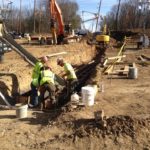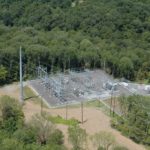- Company: HC Constructors, Inc.
- Industry: Power
- Location: West Amwell, New Jersey
- Expected Completion Date: July 31, 2015
- Project Website
The Rocktown Substation project is an electrical substation expansion built in West Amwell, Hunterdon County, New Jersey for Jersey Central Power & Light. The construction expansion project included new 230-kilovolt circuit breakers, transformers and other equipment to reduce the transmission line voltage to a level that can be used by local customers. The Rocktown Substation improvements benefit over 75,000 people in the surrounding areas. This project included nearly 4 acre of tree clearing, 1800 cy rock excavation and blasting, 10,470 sf of precast concrete bin type retaining walls, 13,350 cy of earth moving and two 800 ft deep grounding rods. The project also included concrete equipment foundations as well as drilled concrete caissons. This is in addition to all of the stormwater piping and mechanical treatment devices, electrical conduit trenches and electrical grounding. All this construction work was to be performed around an existing live electrical substation.
What impact does this project have on America?
These improvement will add benefit to the surrounding counties which is approximately 75,000 people. It will add another power source that will enhance resiliency to the system and allows switching to other circuits, which is expected to shorten power outages when they occur.
What interesting obstacles or unusual circumstances did you overcome to complete the project?
Due to permit constraints, the project had a late start. The overall project was to last approximately 5 months from October 2014 to March 2015. The client requested that HC Constructors be substantially complete in 46 days in order to allow the steel and equipment to be set before the summer power demand. An accelerated schedule of 12 hour days, 6 days a week as well as additional crews were utilized to compete the project by December 15, 2014.
Subcontractors and materials were coordinated and planned where several areas of work could be performed at the same time. The building up of the site with fill material and precast bin walls, blasting of the rock, the drill rig for the 800 lf deep grounding rods and the construction of the foundations were all being worked on near and in the existing live substation. There also were significant rain during this time. The project was substantially complete by December 15, 2014 safely with no loss time accidents and within budget. Final restoration was completed by July 2015.
What dangers and risks did you encounter, and describe any extraordinary methods used to keep workers safe?
One danger that we faced is working near a live substation. With many crews and subcontractors working long hours around this live substation, safety task analysis meetings were held daily. Blasting also occurred several feet away from the live substation. To keep everyone safe, preblast meetings were held. Horns were sounded three times both before and after the blasts. Between horns, no personnel was allowed onsite. Everyone had to stay in the safety zone until the all clear horns sounded.
How did you leverage new technologies to work faster and reduce waste?
Foreman were given ipads that were used to communicate with the main office. The foreman in the field would document paperwork and pictures via ipdad applications. Timesheets for all the crews were transmitted to the main office with ipad applications. This technology help the faced paced site keep track of all material coming into the site and all labor hours.









